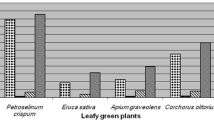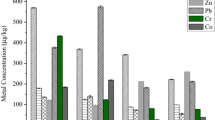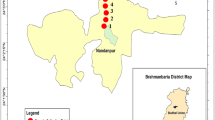Abstract
Heavy metal contamination in water, soil and crops has become an increasing health problem. The present study aimed to investigate potential health risks to public health by evaluating the mean metal concentrations in water, soil and Cucurbita maxima (pumpkin) samples collected from three different irrigation areas using canal water (CWI), groundwater (GWI) and municipal wastewater (MWI). Concentrations of copper (Cu), lead (Pb), iron (Fe), cobalt (Co), zinc (Zn), cadmium (Cd) and nickel (Ni) in collected soil and vegetable samples were estimated through atomic absorption spectrophotometer. Molybdenum (Mo) level in the specimens was analysed by graphite furnace and the flow injection hydride generation AAS was employed for arsenic (As) and the fluorometric method was used for determination of selenium (Se) contents. The metal concentrations in pumpkin samples were ranged from 7.75 to 9.01, 2.82 to 4.03, 0.43 to 0.74, 34.41 to 41.60, 16.76 to 20.15, 29.87 to 34.15, 6.86 to 8.99, 5.99 to 7.86, 3.55 to 3.91 and 0.13 to 0.16 mg/kg for Mo, As, Se, Fe, Cu, Zn, Ni, Pb, Cd and Co, respectively. Likewise, the concentrations of Pb, Mo and Cd in the pumpkin at all irrigation sites were estimated to be above the respective maximum permissible levels. Arsenic, at the MWI site, posed the highest risk threat (HRI = 77. 34) for public health. The highest pollution load index (PLI) was estimated for Ni (4.21) at the GWI site indicating soil contamination. According to the findings of this study, the amount of potentially toxic metals in all sample waters, especially municipal wastewater, is at a level that may pose a risk to human health.

Similar content being viewed by others
Data availability
All data generated or analysed during this study are included in this published article.
References
Ahmad K, Ashfaq A, Khan ZI et al (2016a) Health risk assessment of heavy metals and metalloids via dietary intake of a potential vegetable grown in contaminated water irrigated agricultural sites of Sargodha. Pakistan Hum Ecol Risk Assess 22(3):597–610
Ahmad K, Khan ZI, Yasmin S et al (2016b) Contamination of soil and carrots irrigated with different sources of water in Punjab. Pakistan Environ Earth Sci 75:426
Ahmad K, Khan ZI, Ashfaq A et al (2016) Contamination and accumulation of heavy metals in brinjal (Solanum melongena L.) grown in a long-term wastewater-irrigated agricultural land of Sargodha. Pakistan. Fresen Environ Bull 25(7):2404–2410
Amadi BA, Akaninwor JO, Igwe FU, Amad EI (2018) Biochemical impact of sludge obtained from wastewater treatment plant on soil properties within Port Harcourt. J Environ Anal Toxicol 8(1):1–5
Amlan K, Ghosh MA, Bhatt HP (2012) Effect of long-term application of treated sewage water on heavy metal accumulation in vegetables grown in Northern India. Environ Monit Assess 184:1025–1036
Balkhair KS, Ashraf MA (2016) Field accumulation risks of heavy metals in soil and vegetable crop irrigated with sewage water in western region of Saudi Arabia. Saudi J Biol Sci 23:32–44
Buat-Menard P, Chesselet R (1979) Variable influence of the atmospheric flux on the trace metal chemistry of oceanic suspended matter. Earth Planet Sci Lett 42(3):399–411
Chao W, Xiao-Chen L, Li-Min Z, Pei-Fang W, Zhi-Yong G (2007) Pb, Cu, Zn and Ni concentrations in vegetables in relation to their extractable fractions in soils in suburban areas of Nanjing. China Polish J Environ Stud 16(2):199–207
Cui YL, Zhu YG, Zhai RH, Chen DY, Huang YZ, Qiu Y (2004) Transfer of metals from soils to vegetables in an area near a smelter in Nanning, China. Environ Int 30:785–791
Dosumu OO, Salam NA, Oguntoy NS (2005) Trace metals bioaccumulation by some Nigerian vegetables. Centrepoint 13(1):23–32
Dutch Standards (2000) Circular on target values and intervention values for soil remediation. Ministry of Housing, Spatial Planning and the Environment, Bilthoven, The Netherlands.
Gee GW, Bauder JW (1986) Particle-size analysis. In: Klute A (Ed.), Methods of soil analysis. American Society of Agronomy, Inc. & Soil Science Society of America, Inc., Madison WI, pp. 383–411.
Karak T, Paul RK, Sonar I, Sanyal S, Ahmed KZ, Boruah RK, Das DK, Dutta AK (2014) Chromium in soil and tea (Camellia sinensis L.) infusion: does soil amendment with municipal solid waste compost make sense? Food Res Int 64:114–124
Khan ZI, Ugulu I, Sahira S, Mehmood N, Ahmad K, Bashir H, Dogan Y (2020b) Human health risk assessment through the comparative analysis of diverse irrigation regimes for Luffa (Luffa cylindrica (L.) Roem.). Journal of Water, Sanitation and Hygiene for Development 10(2):249–261. https://doi.org/10.2166/washdev.2020b.132
Khan ZI, Nisar A, Ugulu I, Ahmad K, Wajid K, Bashir H, Dogan Y (2019) Determination of cadmium concentrations of vegetables grown in soil irrigated with wastewater: evaluation of health risk to the public. Egypt J Bot 59(3): 753–762. https://doi.org/10.21608/ejbo.2019.9969.1296
Khan ZI, Safdar H, Ahmad K, Wajid K, Bashir H, Ugulu I, Dogan Y (2020a) Copper bioaccumulation and translocation in forages grown in soil irrigated with sewage water. Pak J Bot 52 (1):111–119. https://doi.org/10.30848/PJB2020a-1(12)
Mathieu C, Pieltain F (2003) Analyse chimique des sols: Méthodes choisies. Lavoisier, Paris
McLean EO (1982) Soil pH and lime requirement. In: Page AL (Ed.), Methods of soil analysis. Second Edition, American Society of Agronomy, Inc. & Soil Science Society of America, Inc., Madison WI, pp 199–224.
Miller JN, Miller JC (2005) Statistics and chemometrics for analytical chemistry, 5th edn. Pearson, London
Murtaza G, Ghafoor A, Qadir M, Owens G, Aziz MA, Zia MA, Saifullah A (2010) Disposal and use of sewage on agricultural land in Pakistan: a review. Pedosphere 20:23–34
Nawaz H, Anwar-ul-Haq M, Akhtar J, Arfan M (2021) Cadmium, chromium, nickel and nitrate accumulation in wheat (Triticum aestivum L.) using wastewater irrigation and health risks assessment. Ecotoxicol Environ Saf 208:111685
Qadir A, Amina Q, Kanwal R, Bano M, Yousaf B (2015) Accessing potential bioaccumulation of heavy metals in selective vegetables from Gujranwala District. Pakistan J Environ Earth Sci 5(8):58–70
Rai PK, Lee SS, Zhang M, Tsang YF, Kim K-H (2019) Heavy metals in food crops: health risks, fate, mechanisms, and management. Environ Int 125:365–385
Sahin I, Akcicek E, Guner O et al (2016) An investigation on determining heavy metal accumulation in plants growing at Kumalar Mountain in Turkey. EurAsian J BioSci 10:22–29. https://doi.org/10.5053/ejobios.2016.10.0.3
Singh A, Sharma RK, Agarwal M, Marshall FM (2010) Health risk assessment of heavy metals via dietary intake of foodstuffs, from waste water irrigated site of dry tropical area of India. Food Chem Toxicol 48(2):611–619
Tariq F, Xiukang W, Saleem MH et al (2021) Risk assessment of heavy metals in Basmati rice: implications for public health. Sustainability 13:8513. https://doi.org/10.3390/su13158513
Uboh FE, Akpanabiatu MI, Edet EE, Okon IE (2011) Distribution of heavy metals in fluted pumpkin (Telfeiria occidentalis) leaves planted at different distances away from the traffic congested highways. Int J Adv Biotech Res 2(2):250–256
Ugulu I (2015) A quantitative investigation on recycling attitudes of gifted/talented students. Biotech Biotechnol Equip 29:20–26
Ugulu I, Khan ZI, Rehman S, Ahmad K, Munir M, Bashir H, Nawaz K (2019) Trace metal accumulation in Trigonella foenum-graecum irrigated with wastewater and human health risk of metal access through the consumption. Bull Environ Contam Toxicol 103:468–475
Ugulu I, Baslar S, Dogan Y, Aydin H (2009) The determination of colour intensity of Rubia tinctorum and Chrozophora tinctoria distributed in Western Anatolia. Biotech Biotechnol Equip 23(SE):410–413
Wajid K, Ahmad K, Khan ZI, Nadeem M, Bashir H, Chen F, Ugulu I (2020) Effect of organic manure and mineral fertilizers on bioaccumulation and translocation of trace metals in maize. Bull Environ Contam Toxicol 104:649–657. https://doi.org/10.1007/s00128-020-02841-w
Wang X, Sato T, Xing B, Tao S (2005) Health risks of heavy metals to the general public in Tianjin, China via consumption of vegetables and fish. Sci Total Environ 350:28–37
WHO (1996) Trace elements in human nutrition and health. Prepared in Collaboration with the FAO of the UN and the IAEA. World Health Organization, Geneva.
WWF (2007) Report on national surface water classification criteria, irrigation water quality guidelines for Pakistan, February–2007. Waste Water Forum, Pakistan.
Xiao W, Ye X, Zhang Q, Chen D, Hu J, Gao N (2018) Evaluation of cadmium transfer from soil to leafy vegetables: influencing factors, transfer models, and indication of soil threshold contents. Ecotoxicol Environ Saf 164:355–362
Author information
Authors and Affiliations
Contributions
SS and NM were responsible for conducting the experiments and the data analysis. IU, YD and ZIK were responsible for analyzing and interpreting the data and writing the manuscript. KA and ZIK supervised the study. All authors read and approved the final manuscript.
Corresponding author
Ethics declarations
Ethical approval
The authors declare that the manuscript has not been published previously.
Consent to participate
All authors voluntarily participated in this research study.
Consent to publish
All authors consent to the publication of the manuscript.
Conflict of interest
The authors declare no competing interests.
Additional information
Responsible Editor: Amjad Kallel
Rights and permissions
About this article
Cite this article
Ugulu, I., Khan, Z.I., Sahira, S. et al. Determination of heavy metal accumulation in wastewater irrigated pumpkin (Cucurbita maxima Duch.) by spectroscopic method. Arab J Geosci 15, 1238 (2022). https://doi.org/10.1007/s12517-022-10519-2
Received:
Accepted:
Published:
DOI: https://doi.org/10.1007/s12517-022-10519-2




